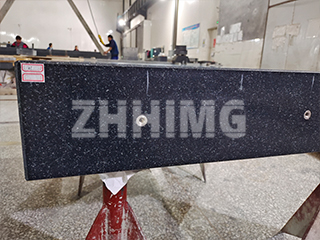When it comes to precision inspection in mechanical manufacturing, machining, and laboratory testing, right-angle squares are indispensable tools for verifying perpendicularity and parallelism. Among the most widely used options are granite squares and cast iron squares. While both serve similar core purposes, their material properties, performance characteristics, and application scenarios differ significantly—making it critical for buyers to choose the right tool for their specific needs. Below is a detailed comparison to help you make an informed decision, whether you’re upgrading your workshop equipment or sourcing for industrial projects.
1. Core Purpose: Shared Functions, Targeted Applications
Both granite squares and cast iron squares feature a frame-style structure with perpendicular and parallel sides, designed to meet high-precision inspection requirements. They are primarily used for:
- Checking the perpendicularity of internal components in various machine tools (e.g., lathes, milling machines, grinders).
- Verifying parallelism between mechanical parts and instruments.
- Serving as a reliable 90° reference standard for precision measurement in industrial production lines and laboratories.
While their core functions overlap, their material-driven advantages make them better suited for distinct environments—something we’ll explore next.
2. Material & Performance: Why the Difference Matters
The biggest gap between these two tools lies in their base materials, which directly impact stability, durability, and precision retention.
Granite Square: The Ultra-Stable Choice for High-Precision Tasks
Granite squares are crafted from natural granite (main minerals: pyroxene, plagioclase, minor olivine, biotite, and trace magnetite), typically featuring a sleek black appearance. What sets this material apart is its formation process—over hundreds of millions of years of natural aging, granite develops an extremely dense, uniform structure. This gives granite squares unmatched advantages:
- Exceptional Stability: Resistant to thermal expansion and contraction, even in environments with temperature fluctuations. It won’t deform under heavy loads, ensuring long-term precision (often maintaining accuracy for years without recalibration).
- High Hardness & Wear Resistance: With a Mohs hardness of 6-7, granite resists scratches, dents, and wear from frequent use—ideal for high-volume inspection tasks.
- Non-Magnetic & Corrosion-Resistant: Unlike metal, granite doesn’t attract magnetic particles (critical for aerospace or electronics manufacturing) and won’t rust or corrode, even in humid or oily workshop conditions.
Best For: High-precision industries like aerospace, automotive parts manufacturing, and laboratory testing—where consistent accuracy and long tool life are non-negotiable.
Cast Iron Square: The Cost-Effective Workhorse for Routine Inspection
Cast iron squares are made from gray cast iron (material grade: HT200-HT250), a widely used metal alloy known for its machinability and affordability. Manufactured in strict compliance with the GB6092-85 standard, these squares deliver reliable performance for standard inspection needs:
- Good Machinability: Cast iron can be precision-machined to achieve tight tolerances (suitable for most general industrial perpendicularity checks).
- Cost-Effective: Compared to natural granite (which requires mining, cutting, and precision grinding), cast iron is more economical—making it a popular choice for small to medium-sized workshops with budget constraints.
- Moderate Stability: Performs well in controlled environments (e.g., workshops with stable temperatures). However, it is prone to slight deformation under extreme heat, cold, or heavy loads, requiring periodic recalibration to maintain accuracy.
Best For: Routine inspection in general manufacturing, tooling workshops, and maintenance tasks—where cost efficiency and standard precision (rather than ultra-high accuracy) are priorities.
3. Which One Should You Choose? A Quick Decision Guide
To help you pick the right square for your project, here’s a simplified comparison table:
|
Feature
|
Granite Square
|
Cast Iron Square
|
|
Material
|
Natural granite (aged over eons)
|
Gray cast iron (HT200-HT250)
|
|
Precision Retention
|
Excellent (no deformation, long-term)
|
Good (needs periodic recalibration)
|
|
Stability
|
Resistant to temperature/load changes
|
Stable in controlled environments
|
|
Durability
|
High (scratch/wear/corrosion-resistant)
|
Moderate (prone to rust if unmaintained)
|
|
Non-Magnetic
|
Yes (critical for sensitive industries)
|
No
|
|
Cost
|
Higher (investment in long-term value)
|
Lower (budget-friendly for routine use)
|
|
Ideal Use Case
|
High-precision manufacturing/laboratories
|
General workshops/routine inspection
|
4. Partner With ZHHIMG for Your Precision Measurement Needs
At ZHHIMG, we understand that the right tools are the foundation of quality manufacturing. Whether you need a granite square for ultra-precise aerospace components or a cast iron square for daily workshop checks, we offer:
- Products that meet international quality standards (GB, ISO, DIN).
- Customizable sizes to fit your specific machine or project requirements.
- Competitive pricing and fast global shipping (supporting export to 50+ countries).
Ready to find the perfect square for your needs? Contact our technical team for personalized recommendations. We’re here to help you elevate your inspection accuracy—no matter your industry!
Post time: Aug-25-2025

